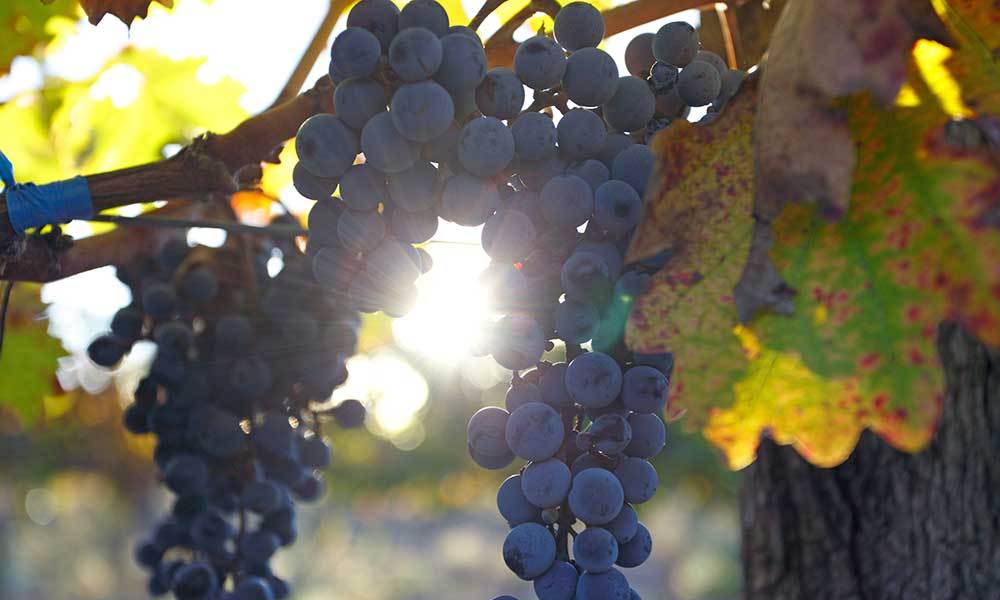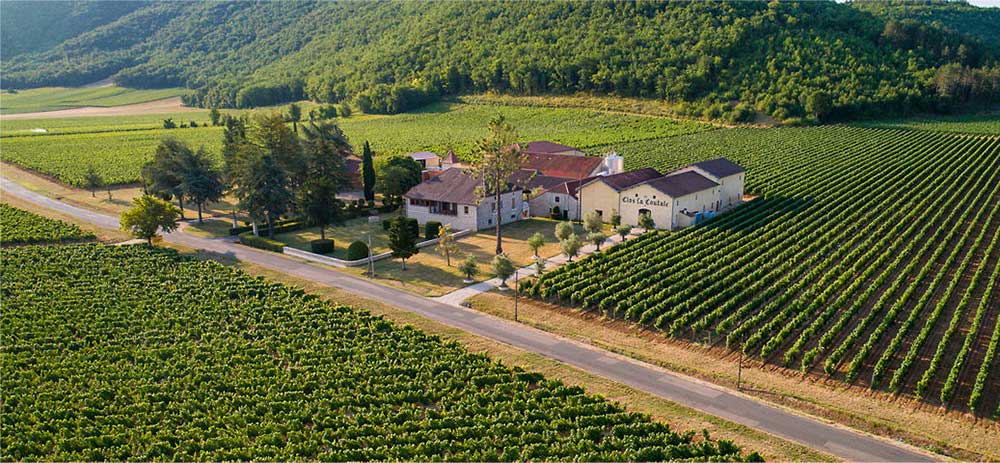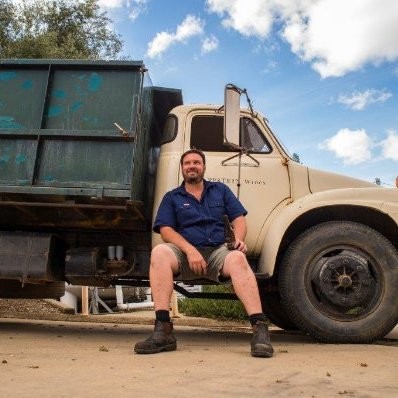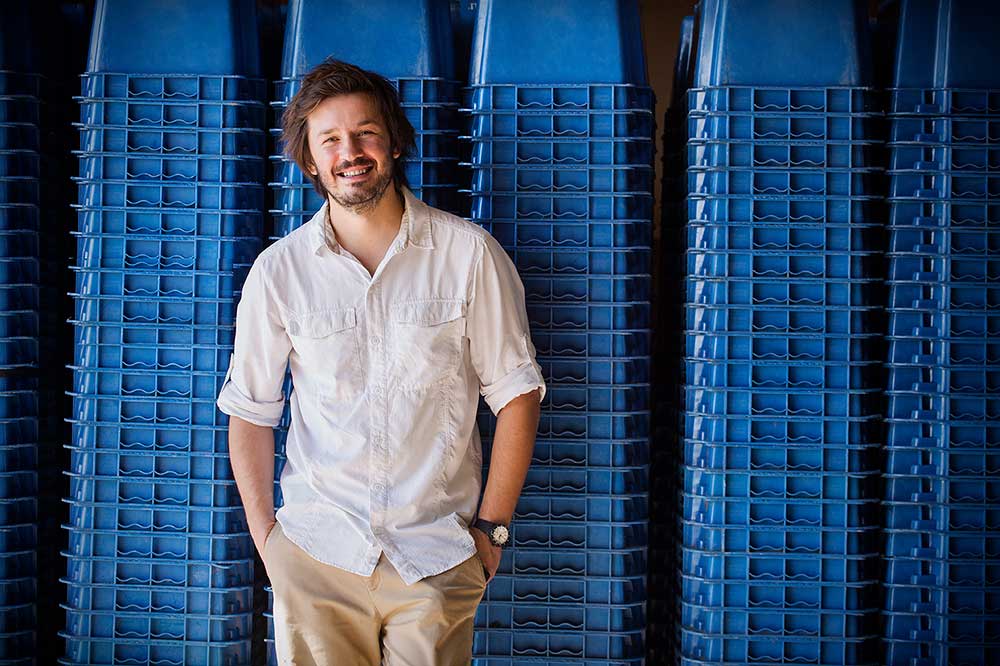Malbec might be familiar to you as one of the six traditional red grapes used in red Bordeaux blends, the other five being cabernet sauvignon, merlot, cabernet franc, petit verdot and rarely carménère. But grown in the right place, malbec is capable of making some great wine in its own right.
 The traditional home of malbec is Cahors in France - one of the country’s oldest vineyard areas and part of the larger South West wine region. Appellation rules allow red wine only, with a minimum of 70% malbec, or cot/auxerrois, as it may be referred to locally, the remainder either merlot or tannat.
The traditional home of malbec is Cahors in France - one of the country’s oldest vineyard areas and part of the larger South West wine region. Appellation rules allow red wine only, with a minimum of 70% malbec, or cot/auxerrois, as it may be referred to locally, the remainder either merlot or tannat.
Cahors sits to the southeast of Bordeaux and was traditionally known for its dark, concentrated and tannic wines which, in years gone by, were said to be used by the Bordelaise to give a little more oomph to their wines. By the early 19th century the ‘black wine’ of Cahors enjoyed quite a reputation, but dramatic frosts in 1956 wiped out an incredible 99% of vineyards, from which it’s taken many decades to recover. More recently though, Cahors seems to be undergoing a bit of a renaissance, as people re-discover this gastronomic region, famous for its duck and some of the best truffles in France.
These days, it’s Argentina that’s synonymous with malbec, with over 75% of the world’s plantings and credited with its global reinvigoration and popularity. Mendoza is the country's most important region, accounting for around 75% of production as well as having some of the world's highest vineyards. Production of malbec started in the mid-19th century when French agronomist Michel Aimé Pouget was invited by the Argentine government to bring new grape varieties to the country, which he did, including malbec. The variety has gone on to become the signature variety of the country, and as The Oxford Companion to Wine observes, “(malbec)… seems more at home in Argentina than in its Cahors homeland.” Argentine malbec tends to be more fruit forward, riper, richer and softer than Cahors, exhibiting flavours of blackberry, plum and black cherry.
Malbec also made its way to Australia in the 19th century, but didn’t really gain any traction here until the 1990s. Plantings are minuscule, accounting for a mere 9,755 tonnes in the 2022 vintage. By comparison, the most crushed variety, shiraz, accounted for 433,305 tonnes. Despite its relative scarcity, as James Halliday notes “grown in the right places and handled the right way, beautiful wines can be made” and the best of those places are Langhorne Creek and Clare Valley.
Here are four malbecs, covering all three countries, that I’ve been enjoying.
 Bleasdale Second Innings Malbec 2020
Bleasdale Second Innings Malbec 2020
Bleasdale is located in Langhorne Creek in SA, one of Australia’s most historic and undervalued regions. Situated about an hour’s drive southeast of Adelaide, the region’s key climatic attributes are its proximity to The Southern Ocean and Lake Alexandrina, both of which serve to cool the otherwise warm conditions. The results are perfect ripening conditions with warm days and cool nights. These conditions give Langhorne malbec medium palate-weight and ripeness, while retaining classic cool climate aromatics of violet and roses. It’s this combination that’s seen Langhorne Creek recognised as the premier malbec region in Australia.
Founded in 1850, Bleasdale was the first winery established in Langhorne Creek and after 170 years of continuous winemaking, it’s still the region’s best. Until the 1960s, the heritage listed winery focussed on fortifieds, but their first table wine, produced in 1961, was a malbec. The estate is still run by direct descendants of the Potts family, their range of over 30 wines now includes red, white, sparkling, fortified and most recently a rosé
Winemaker Paul Hotker is a bit of a superstar, albeit a modest one. His wines have won too many awards, trophies and gold medals for me to list. One of his wines won the highly coveted Jimmy Watson Trophy at the 2019 Royal Melbourne Wine Awards and the 2016 vintage of this wine was awarded the prestigious Max Schubert Trophy for most outstanding wine at the 2018 Royal Adelaide Wine Show.
Paul’s talents were recognised when he was awarded Winemaker of the Year 2018 by James Halliday, who describes him as “the master of Malbec in Australia.”
The Bleasdale Second Innings Malbec 2020 is the estate’s entry level malbec, with the label depicting Frank Potts II, the sixth mover-and-shaker son of founder Frank Potts, taking part in a family game of cricket on the Bleasdale property. The wine is made from 100% malbec grapes that, post ferment, were left ‘on skins’ for 7–10 days before being transferred to oak (10% new, 90% seasoned) for 9 months - both processes designed to add a little extra complexity and depth.
"Part estate-grown fruit, part contract-grown; open fermented with 20% whole berries, on skins 7-10 days; matured for 9 months in French puncheons and hogsheads (10% new). Bright colour. A highly aromatic bouquet with the particular spice – half pepper, half clove – of Bleasdale Vineyards. The palate is a broad church of plum, blackberry and red cherry – and a hint of clove on the finish. Outstanding value. Drink by 2032."
95 points. James Halliday – Australian Wine Companion.
Trophy for Best Single Varietal Red and Top Gold - Melbourne Royal Wine Awards 2021
Silver - Sydney Royal Wine Show 2022
Silver - Royal Adelaide Wine Show 2021
Silver - Perth Royal Wine Awards 2021
Silver - Langhorne Creek Wine Show 2022
Best malbec region in Australia, best malbec winemaker in Australia.
I can offer it for $18 a bottle.
 Clos La Coutale Cahors Malbec 2020
Clos La Coutale Cahors Malbec 2020
The earliest part of Clos La Coutale’s cellar dates back to 1779, making it one of the oldest domaines in Cahors. Philippe Bernède has been at the helm since 1985 and is the 6th generation of his family to make wine at the 100ha estate, whose vineyards lie on the gentle alluvial slopes that rise up from the Lot River.
“For at least two decades, the Clos la Coutale’s wine has been unmistakable in flavour personality and offered terrific value,” David Schildknecht, The Wine Advocate.
The wine is imported into the US by wine guru Kermit Lynch, which itself is a huge endorsement: “In the lunchroom of our Berkeley retail shop, two shelves line the wall next to our kitchen table. On these shelves stand the best, most memorable wines ever tasted on these premises. Names like Jayer, Coche-Dury, Tempier, and Domaine de la Romanée-Conti jump out, and vintages date back to the ‘50s and ‘60s. Upon closer inspection of our ‘Wall of Fame,’ certain ‘unexpected’ bottles appear: a 1985 Côtes du Rhône Cuvée Sélectionée par Kermit Lynch, a 1961 Savennières from Château d’Epiré, and tasted just a few years ago, a 1959 Cahors from Clos la Coutale. The presence of Clos la Coutale amongst the titans of Burgundy is a testament to the phenomenal quality this domaine has offered us for now more than three decades.”
Past vintages of the wine have been named in Wine Spectator’s Top 100 (2009) and Wine Enthusiasts Top 100 Best Buys (2014).
 Clos La Coutale vineyards.
Clos La Coutale vineyards.
The wine is a blend of 80% malbec and 20% merlot, although sometimes there’s also a touch of tannat. The merlot tends to add a touch of softness to the wine. Various parcels of fruit from the vineyard were fermented separately in stainless steel, after which they were blended and spent 12 months in ‘foudre’ which are larger than typical oak barrels. The finished wine is 13.5% alcohol and is sealed with cork.
Aromas of dark fruit, blackberry, and blackcurrant meld with a hint of spice and vanilla from the oak. On the palate, the wine is full-bodied and rich, with notes of black cherry, plum, and a touch of earthiness. The tannins are firm, yet well-integrated, providing structure and balance to the wine.
You’ll find it at Et Al in Potts Point for $60 a bottle.
I can offer it for $28 a bottle.
 Tonic Wines Clare Valley Malbec 2021
Tonic Wines Clare Valley Malbec 2021
Tonic Wines is the work of Glenn Barry, who back in the early noughties studied Applied Science and Oenology at Charles Sturt Uni at Wagga. Stints at big wineries in Italy, the US, Canada and Australia followed, including at Hardy’s, first in Mildura and then at Tintara in McLaren Vale, where he ended up being Senior Winemaker. In 2010 Glenn moved to the Clare to take on the role of Chief Winemaker at another big-end-of-town winery, Knappstein. Experience as a wine show judge also adds to Glenn’s breadth of experience and knowledge.
But the itch to step away from large-scale corporates and create handcrafted small batch wines, finally got the better of Glenn in 2014. He and a marketing mate started Tonic Wines, initially as a hobby, selling just a barrel of Barossa mataro to family and friends. The name Tonic is a reference to mysterious brewers of the past known for created enticing and mystical concoctions. And while the name Tonic conjures up ideas of well-being and longevity, their motto of “It’ll do nothing for your health but plenty for your soul” made me chuckle the first time I saw it. Success followed and in 2018 Glenn bought out his mate, turning his full attention to Tonic Wines. These days Glenn produces a range of wines, out of Greenock, in the Barossa
Glenn’s winemaking style is about vibrant and juicy, fruit-driven wines. Wines that feel good in your mouth and that people, including me, love to drink. His winemaking uses minimal intervention, backed by a solid scientific background. It’s ‘natural’ winemaking, at its best.
 Left: Winemaker Glenn Barry.
Left: Winemaker Glenn Barry.
When I met him last year, it was this wine that really piqued my interest. A malbec, with fruit sourced from 35-year-old vines in the Seven Hills sub-region of the Clare Valley, the Clare of course being home to the legendary malbec wines of Wendouree.
The wine was fermented using wild yeasts, basket pressed and post ferment spent 15 days on skins, followed by 8 months in old barrels. The finished wine is 13.7% alcohol, comes in a groovy tonic-like bottle and is sealed with a cork.
Deep and dark with aromas of blackberry, black cherry, and a hint of spice. On the palate, the wine is full-bodied and rich, with flavours of black fruit, plum, and a touch of earthiness. The tannins are firm and the acidity is bright, giving a lovely freshness and a real juiciness to this wine.
“Baked plum, slightly malty, some mint and rosy perfume. Ripe black plum and dark chocolate, carries some of the classic Malbec perfume though, ripe sooty tannin, coffee and roast meat, clean acidity, and a robust finish of good length. It’s a grand mouthful of flavour and texture, and while pushing it a little in the ripeness stakes, offers plenty of pleasure. If you eat meat, then char grilled beef would be ideal with it.” 93 points, Gary Walsh, The Wine Front.
I can offer it for $37 a bottle.
 Riccitelli Wines Hey Malbec! 2021
Riccitelli Wines Hey Malbec! 2021
Matías Riccitelli is an exciting young producer in the region of Lujan de Cuyo within Mendoza, the region of Argentina that put malbec back on the world map. Lujan de Cuyo (and Maipo) are referred to as the ‘primera zone’, the premium winemaking area of Argentina.
Matías was born and bred in Argentina and is a mixture of skilled, traditional winemaker and dynamic hipster. After studying winemaking, he became winemaker at the French owned Fabre Montmayou (Mendoza), one of Argentina’s most prestigious wineries. Matías’ father Jorge Riccitelli is a famous winemaker, working at Bodega Norton (Mendoza) and was the first Latin American to be awarded Winemaker of the Year (in 2012) by prestigious US magazine Wine Enthusiast. Not to be outdone, Matías was awarded ‘Young Winemaker of the Year’ by Tim Atkin MW in 2016. He was awarded Enólogo del Año (Winemaker of the Year) for 2021 byDescorchados, the most influential wine guide in the South Americas. Decanter Magazine’s 2021 article South American Trendsetters: Five names to Know, included Matías, proclaiming “this restless Mendoza winemaker has taken the Argentinian wine scene by storm.”
Since 2009, Matías has been doing his own thing. His winery in Las Compuertas is located at an incredible 1,100M above sea level! This altitude is what distinguishes viticulture here, providing a high diurnal variation (ie. hot day, cool night) meaning slow ripening, which is crucial to flavour development. Without the elevation, conditions at this latitude would be way too hot.
With 20ha of vines planted between 1927-1930, Matías tends them as organically as possible. In the winery he manages to combine the traditional and contemporary, making his wines by hand, without additions, while using modern technology where necessary.
Matías creates a range of interesting wines, including ‘The Apple doesn’t Fall Far from the Tree’ (in reference to his winemaking father), ‘Old vines from Patagonia’ and ‘Republica del Malbec.’ All sport groovy labels and are made in Matias’ modern/tradition melding style.
Hey Malbec! 2021 is 100% malbec that’s hand harvested and made with no additives. Post ferment, 70% was aged in concrete tanks, the balance in old (ie. no oakiness imparted) French barrels. Matías says he “looks for freshness and purity of vibrant malbec” which is why he avoids any oak influence. The finished wine is 14% alcohol and sealed with cork.
 Matías Riccitelli.
Matías Riccitelli.
“Quality is soaring in the Argentinian wine scene and it is wines like the Hey Malbec from Riccitelli that are leading the charge.” Luis Gutierrez - wine critic who reviews Spanish, Chilean and Argentinian wines for The Wine Advocate.
“Malbec is the Argentinian flagship variety and this beautiful wine is a truly sublime interpretation. Juicy black fruits combine with violets and black pepper, with soft and ripe tannins leading a soft and opulent finish. Lovely on its own or with juicy red meat.” Winemaker’s notes.
In the glass this is dense, dark purpley red. On the nose you’ll find dark plummy fruit, blueberry and dark chocolate. On the palate: dense, mouth-coating red fruit - plums and strawberries. Smooth tannins and crisp acid counterbalance. So concentrated and juicy - this has power and vibrancy… and a cool label.
“Floral, tangy and bright, Hey! is as appealing as its comic book label, with supple tannins and juicy bramble, aniseed and blackberry flavours. Essence of Argentina at a great price.” 91 points, Tim Atkin MW.
You’ll find it on the list of lots of cool joints around town, including overlooking the harbour at Catalina in Rose Bay for $90 a bottle.
I can offer it for $37 a bottle.